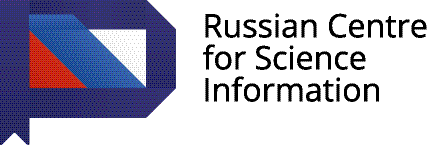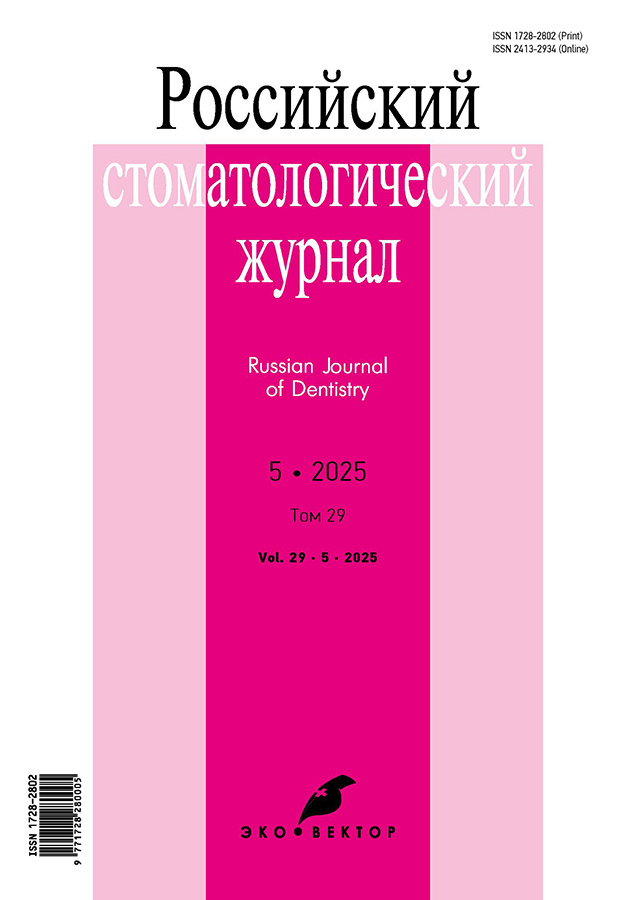Assessment of observer variation in identifying craniometric landmarks and calculating radiographic anatomic indices of the temporomandibular joint: a cross-sectional study
- 作者: Slesarev O.V.1, Sargsyan K.T.1, Komarova M.V.2, Polyarush N.F.3, Bairikov I.M.1, Samutkina M.G.1, Belanov G.N.1, Samykin A.S.1, Aleshkova Y.V.4
-
隶属关系:
- Samara State Medical University
- Samara National Research University named after academician S.P. Korolev
- Reaviz Medical University
- ESPO
- 期: 卷 29, 编号 5 (2025)
- 页面: 333-342
- 栏目: Original Study Articles
- URL: https://bakhtiniada.ru/1728-2802/article/view/349771
- DOI: https://doi.org/10.17816/dent689252
- EDN: https://elibrary.ru/UCGBIJ
- ID: 349771
如何引用文章
详细
BACKGROUND: One of the key tasks of contemporary dentistry is the analysis of radiographic images of the temporomandibular joint. Errors arising during analysis of cone-beam computed tomography data of the temporomandibular joint may lead to incorrect radiologic interpretation and inadequate treatment planning.
AIM: This work aimed to determine the extent to which observer variation influences the radiologic interpretation of temporomandibular joint status based on cone-beam computed tomography data.
METHODS: Сone-beam computed tomography scans of the facial bones were obtained from 20 patients (14 women, 6 men; age range, 25–64 years) with temporomandibular joint disorders. To assess the impact of observer variation on the analysis of cone-beam computed tomography images of the temporomandibular joint, unified software and a standardized protocol for identifying craniometric landmarks were used to calculate the anatomic and topographic position of the mandibular condyle. Cone-beam computed tomography analysis was performed using our method of automated craniometry of cranial anatomical structures (Certificate of State Registration of Computer Programs No. 2017662860). The obtained data were used to analyze deviations in calculations.
RESULTS: The study revealed substantial systematic and random errors in the assessment of the analyzed craniometric parameters, which are unacceptable in clinical practice.
CONCLUSION: To reduce the impact of observer variation on radiologic interpretation in cone-beam computed tomography analysis of the facial bones, training programs should include not only theoretical instructions but also substantial time for workplace internship under the supervision of an experienced mentor.
作者简介
Oleg Slesarev
Samara State Medical University
Email: o.slesarev@gmail.com
ORCID iD: 0000-0003-2759-135X
SPIN 代码: 4507-6276
MD, Dr. Sci. (Medicine), Associate Professor
俄罗斯联邦, SamaraKarina Sargsyan
Samara State Medical University
编辑信件的主要联系方式.
Email: sukasyan_karina@mail.ru
ORCID iD: 0009-0004-1076-9961
SPIN 代码: 2297-3180
俄罗斯联邦, Samara
Marina Komarova
Samara National Research University named after academician S.P. Korolev
Email: marinakom@yandex.ru
ORCID iD: 0000-0001-6545-0035
SPIN 代码: 4359-2715
Cand. Sci. (Biology), Associate Professor
俄罗斯联邦, SamaraNatalia Polyarush
Reaviz Medical University
Email: polyarushnf@mail.ru
ORCID iD: 0009-0000-3979-6737
SPIN 代码: 6496-3920
MD, Dr. Sci. (Medicine), Associate Professor
俄罗斯联邦, SamaraIvan Bairikov
Samara State Medical University
Email: dent-stom@mail.ru
ORCID iD: 0000-0002-4943-2619
SPIN 代码: 3890-6863
MD, Dr. Sci. (Medicine), Professor
俄罗斯联邦, SamaraMarina Samutkina
Samara State Medical University
Email: m.g.samutkina@samsmu.ru
ORCID iD: 0000-0001-6507-9272
SPIN 代码: 1602-5530
MD, Cand. Sci. (Medicine), Associate Professor
俄罗斯联邦, SamaraGenadii Belanov
Samara State Medical University
Email: belanov63@mail.ru
ORCID iD: 0000-0003-0015-9903
SPIN 代码: 3305-8011
MD, Cand. Sci. (Medicine), Associate Professor
俄罗斯联邦, SamaraAlexander Samykin
Samara State Medical University
Email: samikin@mail.ru
ORCID iD: 0009-0000-7570-158X
SPIN 代码: 5875-9758
俄罗斯联邦, Samara
Yulia Aleshkova
ESPO
Email: al-julia@mail.ru
ORCID iD: 0009-0003-8368-809X
俄罗斯联邦, Saint Petersburg
参考
- Bulycheva EA. A differentiated approach to the development of pathogenetic therapy in patients with temporomandibular joint dysfunction complicated by masticatory muscle hypertension [dissertation]. Saint Petersburg, 2010. 331 p. (In Russ.) EDN: QFKLWF
- Naidanova IS. Features of functional disorders of the temporomandibular joint and chewing muscles in young patients with preserved dentition [dissertation]. Saint Petersburg, 2020. 141 p. (In Russ.) EDN: AJYKTI
- Potapov VP. Etiology, pathogenesis, diagnostics, and complex treatment of patients with temporomandibular joint diseases caused by functional occlusion disorders. Samara: Izdatel’sko-poligraficheskij kompleks “Pravo”; 2019. 351 p. (In Russ.) EDN: MWPLCY
- Vasiliev AY, Drobyshev AY, Drobysheva NS, et al. Diseases of the temporomandibular joint. Moscow: Izdatel’skaja gruppa “GJeOTAR-Media”; 2022. 360 p. (In Russ.) doi: 10.33029/9704-6079-5-SUR-2022-1-360 EDN: RDIBKE
- Greene C, Manfredini D, Ohrbach R. Creating patients: how technology and measurement approaches are misused in diagnosis and convert healthy individuals into TMD patients. Front Dent Med. 2023;12;4:1183327. doi: 10.3389/fdmed.2023.1183327 EDN: IYVECN
- Barghan S, Tetradis S, Mallya S. Application of cone beam computed tomography for assessment of the temporomandibular joints. Aust Dent J. 2012;57 Suppl. 1:109–118. doi: 10.1111/j.1834-7819.2011.01663.x
- Hunter A, Kalathingal S. Diagnostic imaging for temporomandibular disorders and orofacial pain. Dent Clin North Am. 2013;57(3):405–418. doi: 10.1016/j.cden.2013.04.008
- Krishnamoorthy B, Mamatha N, Kumar VA. TMJ imaging by CBCT: Current scenario. Ann Maxillofac Surg. 2013;3(1):80–83. doi: 10.4103/2231-0746.110069
- Jaber M, Khalid A, Gamal A, et al. A comparative study of condylar bone pathology in patients with and without temporomandibular joint disorders using orthopantomography. J Clin Med. 2023;12(18):5802. doi: 10.3390/jcm12185802 EDN: BEKBFO
- Domenyuk DA, Davydov BN, Dmitrienko SV, et al. Diagnostic opportunities of cone-box computer tomography in conducting craniomorphological and craniometric research in assessment of individual anatomical variability. The Dental Institute. 2019;(2):48–53. EDN: XNTSZD
- Hassan B, Nijkamp P, Verheij H, et al. Precision of identifying cephalometric landmarks with cone beam computed tomography in vivo. Eur J Orthod. 2013;35(1):38–44. doi: 10.1093/ejo/cjr050
- Serov VV. General pathological approaches to the study of disease. 2nd edition. Moscow: Medicina; 1999. 304 p. (In Russ.) ISBN: 5-225-04409-3
- Slesarev OV. Anatomic rationale and radiological experience in using an individual anatomical landmark during linear imaging of the human temporomandibular joint. Journal of Radiology and Nuclear Medicine. 2014;(3):46–51. (In Russ.) doi: 10.20862/0042-4676-2014-0-3-1-12 EDN: SICAOR
- Slesarev OV. Diseases of the temporomandibular joint: an interdisciplinary approach to diagnosis and treatment. Saint Petersburg: Izdatel’stvo “Chelovek”; 2022. 284 с. (In Russ.) EDN: IMBUKV
- Farook TH, Dudley J. Understanding occlusion and temporomandibular joint function using deep learning and predictive modeling. Clin Exp Dent Res. 2024;10(6):e70028. doi: 10.1002/cre2.70028 EDN: ENXLGD
- Brüning LL, Rösner Y, Meisgeier A, Neff A. Arthroscopic assessment of temporomandibular joint pathologies — is it possible for non-specialists in arthroscopy? Analysis of variability and reliability of dental students’ ratings after a comprehensive one-semester introduction. J Clin Med. 2024;13(14):3995. doi: 10.3390/jcm13143995 EDN: WTJDLK
补充文件








